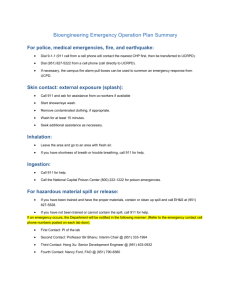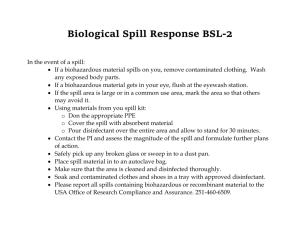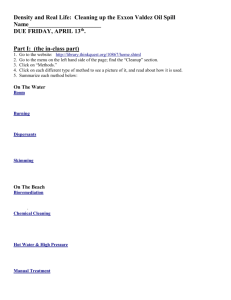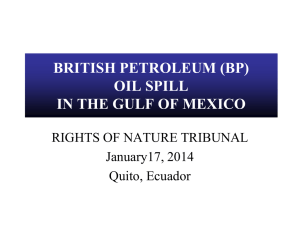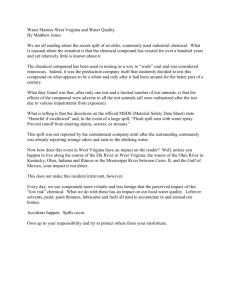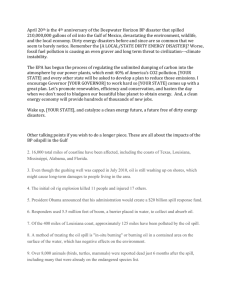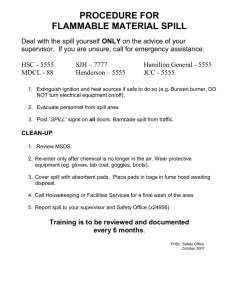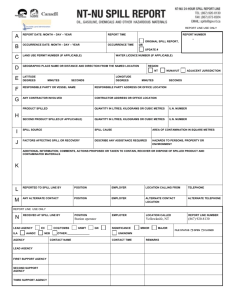The Deepwater Horizon Oil Spill
advertisement
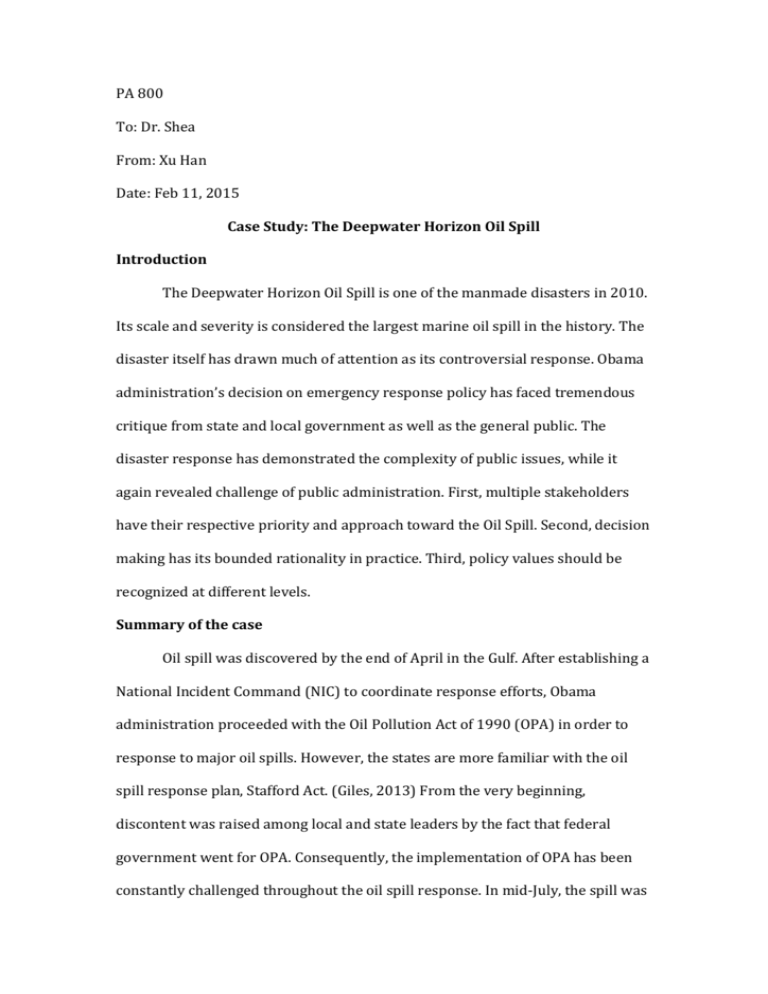
PA 800 To: Dr. Shea From: Xu Han Date: Feb 11, 2015 Case Study: The Deepwater Horizon Oil Spill Introduction The Deepwater Horizon Oil Spill is one of the manmade disasters in 2010. Its scale and severity is considered the largest marine oil spill in the history. The disaster itself has drawn much of attention as its controversial response. Obama administration’s decision on emergency response policy has faced tremendous critique from state and local government as well as the general public. The disaster response has demonstrated the complexity of public issues, while it again revealed challenge of public administration. First, multiple stakeholders have their respective priority and approach toward the Oil Spill. Second, decision making has its bounded rationality in practice. Third, policy values should be recognized at different levels. Summary of the case Oil spill was discovered by the end of April in the Gulf. After establishing a National Incident Command (NIC) to coordinate response efforts, Obama administration proceeded with the Oil Pollution Act of 1990 (OPA) in order to response to major oil spills. However, the states are more familiar with the oil spill response plan, Stafford Act. (Giles, 2013) From the very beginning, discontent was raised among local and state leaders by the fact that federal government went for OPA. Consequently, the implementation of OPA has been constantly challenged throughout the oil spill response. In mid-July, the spill was finally under control and stopped. The damage to the Gulf coast is imaginable, but Obama administration has successfully put BP in the situation where they were fully responsible for this disaster. Key stakeholders A few key stakeholders has played significant role in the Oil Spill response. Holding respective interests, state and local government held large participation in the whole process, for they are accountable for their constituents. Federal government, as the decision maker, has made critical decision on Oil Spill response policy, as well as the decisions on response coordination. BP, an important stakeholder, is responsible for the Oil Spill, therefore, it has been seeking ways to seal off the Macondo Well. With the time passing by, the general public has increasingly raised their concern and anger to exert pressure on local government and federal government. Identified problems Decision-making One of disputes in Deepwater Horizon Oil Spill is the decision on response policy, OPA or Stafford Act. Once Obama administration proceeded OPA, state and local government immediately given resentment to this decision, because they believe that this Oil Spill is one of the other spills that they have responded to under their familiar policy, Stafford Act. OPA has its obvious limitation in terms of the policy itself, which it has passed in 1990 and it was dealt with surface oil, but not the deepwater oil. However, this policy requires BP to be fully responsible for clean-up costs. (Giles, 2013) On one hand, the state and local government believe they know what to do better than the federal government. “we all resent those who have authority over us when we suspect that we know more about life on the firing line than they do.” (Perrow, 1986) The federal government, on the other hand, were “muddling through” an urgency. (Lindblom, 1959) OPA might have offered values at the cost of big risk, time consuming, than Stafford Act. Lack of understanding between local governments and federal governments over the decision-making is a severe problem in this case. Trust Issue Despite the fact that ceasing the oil spill is urgent, response expertise didn’t gain much trust from the local government. As the severity of the disaster increased, local government started to force more pressure on federal government and Coast Guard on the matter of deploying boom. Coast Guard is supposed to be the expert of Oil Spill response, yet it doesn’t have the power compare to local government. A conflict between professional values and bureaucratic values rose. (Perrow, 1986) Professionals only care about how to get their job done well, while bureaucrats care about their constituents and their public image. If local government thought that federal government has stuck its nose into Oil Spill response too much, they should have examined how much they interfere with responders. Therefore, there is a lack of trust between government and expertise. Recommendations Means and Ends Means and ends relationship is a theory that Lindblom has proposed in his root method. Decision-making is a means-ends relationship where means to be evaluated and chosen in the light of ends. (Lindblom, 1959) In this case, it is recommended to consider this relationship in order to make a sound decision in which will minimize the impact of Oil Spill. It is better to foresee the ends, what to achieve, before making a decision on means. Stakeholder analysis Second recommendation is to conduct a stakeholder analysis either before making a decision or after. Stakeholder analysis will help to identify the interests and power grid. It provides a picture of where the emphasis of the issue is and who will be the most impacted, furthermore, it helps to outline a winning argument. (Bryson et al, 2002) It is important for the leadership to keep in mind that to minimize discrepancy among stakeholders, for it is likely to slow down things. And for such a major disaster, nobody wants the response slow down. Cost and efficiency analysis Last recommendation would be cost and efficiency analysis, or costefficiency forecast. Efficiency is a ratio between resources and results, which can be assessed in the light of public values. (Meer & Rutgers, 2010) In this case, between OPA and Stafford Act, it is worthwhile to make an assessment of resources and values of these two plans, so that a more rational decision could be made. Conclusion The Deepwater Horizon Oil Spill has revealed some major problems in the action of response, yet it has again given us a lesson not only on disaster management, but also on political and administrative issues. Even though there is no absolute right or wrong policy, it is important to weigh the values of policies and to make a decision, which would generate minimum impact on the public. References Giles, David W. (2013) The Deepwater Horizon Oil Spill: The Politics of Crisis Response (B). Case Number 1982.0. Cambridge, MA: Case Program, John F. Kennedy School of Government, Harvard University. Perrow, Charles. (1986) Complex Organizations: A Critical Essay, 3rd Edition. New York: Random House. Lindbolm, Charles E. (Spring, 1959) The Science of “Muddling Through”. Public Administration Review, Vol. 19, No. 2. Blackwell Publishing on behalf of American Society for Public Administration. Bryson, John M, Cunningham, Gary L. & Lokkesmoe, Karen J. (2002) What to Do When Stakeholders Matter. The Case of Problem Formulation for the African American Men Project of Hennepin County, Minnesota. Public Administration Review 62(5): 568-584 Meer, v., Rutgers, M. (2010). The Origins and Restriction of Efficiency in Public Administration: Regaining Efficiency as the Core Value of Public Administration. American & Society, 42(7), 755-779
